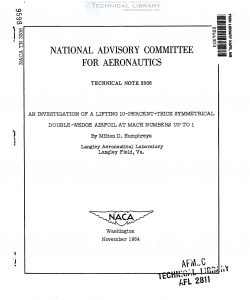naca-tn-3306
- Version
- 112 Downloads
- 1.18 MB File Size
- 1 File Count
- January 23, 2017 Create Date
- January 23, 2017 Last Updated
National Advisory Committee for Aeronautics, Technical Notes - An Investigation of a Lifting 10% Thick Symmetrical Double Wedge Airfoil at Mach Numbers up to 1

Pressure measurements on the surface of a two-dimensional symmetri-
cal double-wedge airfoil have been obtained from tests in the Langley
h- by 19-inch semiopen tunnel at lifting conditions and at Mach numbers
up to l. The object of this investigation was to Obtain normal-force,
pressure—drag, and pitching-moment data and to compare them.with avail-
able experimental and theoretical results.
The nonlifting results are in good agreement with potential-flow
theory at a Mach number of about 0.5 and in fair agreement with the
theoretical results of Guderley and Yoshihara at a Mach number of l and
with the transonic small—disturbance theories of other investigators
for Mach numbers from 0.85 to 1.0.
Below a reduced Mach number go of approximately —l.O, the pressure-
drag coefficient computed on the basis of the transonic theories and the
drag coefficient measured in the present investigation are of Opposite
sign. The present experimental data and the theoretical incompressible
results extended to high—subsonic speeds both indicate a thrust for the
forebody. The application of transonic approximations, therefore, appears
unjustified for similarity parameters less than approximately -l.0 in the
subsonic portion of the transonic range.
At lifting conditions, for Mach numbers up to about 0.6, the
present results are in good agreement with the closed—tunnel data of
Bartlett and Peterson and with low-speed theoretical data extended to
a Mach number of 0.6.
Among airfoil profiles, the wedge is of particular interest, since
its geometric simplicity permits ready formulation of a problem with
known boundary conditions in the hodograph plane. Consequently, it has
been the subject of considerable theoretical work in the transonic Mach
number range. Guderley and Yoshihara (ref. 1) first obtained a solution
to the problem of the flow past a thin double-wedge profile at 0° angle
of attack and a Mach number of l. Trilling (ref. 2) has also made an
analytical study of steady plane flow of an ideal gas past a thin, symr
metrical double-wedge profile at 0° angle of attack at transonic Mach
numbers. Previously reported experimental investigations (refs. 3 and
b) have provided data on lO—percent—thick symmetrical double-wedge air-
foils at 00 angle of attack and transonic Mach numbers.
| File | Action |
|---|---|
| naca-tn-3306 An Investigation of a Lifting 10% Thick Symmetrical Double Wedge Airfoil at Mach Numbers up to 1.pdf | Download |
Comment On This Post